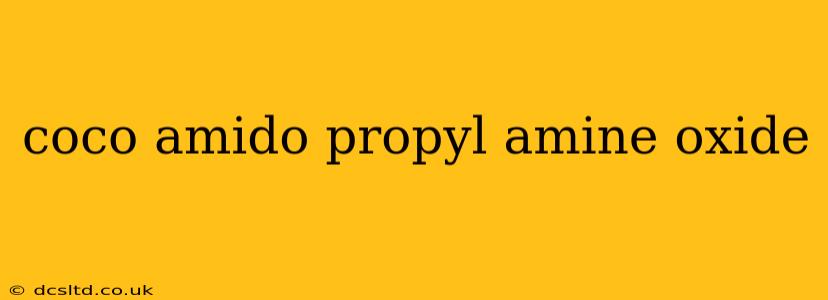Coco amido propyl amine oxide (CAPA) is a fascinating ingredient commonly found in a wide array of personal care products. Its versatility stems from its unique properties as a surfactant, boasting both cleansing and conditioning capabilities. This in-depth exploration will unravel the mysteries surrounding CAPA, covering its chemical makeup, applications, benefits, and potential drawbacks.
What is Coco Amido Propyl Amine Oxide (CAPA)?
CAPA is a non-ionic surfactant derived from naturally occurring coconut oil. It’s a complex molecule, chemically classified as an alkylamide, meaning it contains both an amide group (–CONH–) and an amine oxide group (–N+(O–)R2). This unique chemical structure is responsible for its remarkable properties. The process involves modifying the fatty acids from coconut oil, resulting in a substance with exceptional foaming, cleansing, and conditioning abilities.
How Does Coco Amido Propyl Amine Oxide Work?
CAPA's functionality centers around its amphiphilic nature. This means it has both hydrophilic (water-loving) and lipophilic (oil-loving) portions within its molecule. This dual nature allows it to effectively interact with both water and oil, making it an exceptional emulsifier and detergent. In shampoos and body washes, CAPA helps to lift dirt and oil from the hair and skin, while simultaneously providing a mild and conditioning effect.
What are the Benefits of Using Coco Amido Propyl Amine Oxide?
CAPA offers several compelling advantages in personal care formulations:
- Excellent Cleansing: Its surfactant properties efficiently remove dirt and oil, leaving hair and skin feeling clean without excessive stripping.
- Mild and Gentle: Unlike harsher surfactants, CAPA is known for its mildness, making it suitable for sensitive skin and hair.
- Rich and Creamy Foam: CAPA produces a luxurious, abundant lather, enhancing the sensory experience of using the product.
- Conditioning Properties: It possesses excellent conditioning effects, leaving hair softer, smoother, and easier to manage. It also helps to improve the overall feel of the skin, reducing dryness and irritation.
- Biodegradability: CAPA is generally considered biodegradable, making it an environmentally friendlier choice compared to some other synthetic surfactants.
What are the Potential Drawbacks of Coco Amido Propyl Amine Oxide?
While generally considered safe, some potential drawbacks should be considered:
- Potential Irritation: Although generally mild, some individuals with extremely sensitive skin might experience mild irritation. Patch testing before widespread use is always recommended.
- Manufacturing Considerations: The production process of CAPA can be somewhat complex compared to other simpler surfactants.
Is Coco Amido Propyl Amine Oxide Safe?
Extensive research indicates that CAPA is generally recognized as safe for use in cosmetic products at recommended concentrations. Organizations like the Cosmetic Ingredient Review (CIR) have evaluated its safety profile, finding it suitable for use in rinse-off products. However, individual sensitivities can vary, and a patch test is advised before incorporating new products containing CAPA into one's routine.
What Products Contain Coco Amido Propyl Amine Oxide?
CAPA finds its place in a wide range of personal care products, including:
- Shampoos: Contributes to effective cleansing and conditioning.
- Conditioners: Enhances smoothness and manageability.
- Body washes: Provides gentle cleansing and a luxurious lather.
- Facial cleansers: Offers mild yet effective cleansing for sensitive skin.
- Other cosmetic formulations: Used as a stabilizer or emulsifier in various products.
How is Coco Amido Propyl Amine Oxide Different from Other Surfactants?
Unlike harsh sulfates like Sodium Lauryl Sulfate (SLS) or Sodium Laureth Sulfate (SLES), CAPA offers a gentler cleansing experience while still providing effective cleaning. Other amine oxides share similar properties but might vary slightly in their foaming characteristics or conditioning abilities. The specific fatty acids used in the production process also influence its final properties.
Is Coco Amido Propyl Amine Oxide Vegan and Cruelty-Free?
The sourcing of coconut oil and the manufacturing process are crucial factors determining whether a specific CAPA product aligns with vegan and cruelty-free standards. Always check the product's labeling and brand information to ensure it meets your ethical requirements.
This comprehensive overview of coco amido propyl amine oxide provides a detailed understanding of its properties, applications, benefits, and potential drawbacks. Remember to always check product labels and conduct a patch test if you have sensitive skin. While generally considered safe and effective, individual reactions can vary.
